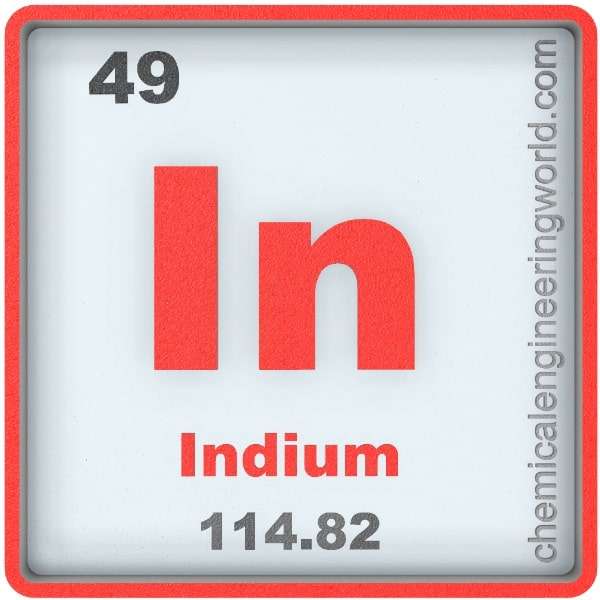Indium Element Properties and Information

Indium Element Properties and Information
Indium is forty-ninth element on the periodic table. Elements are arranged in the periodic table on the basis of the atomic number. Atomic number is the number of protons in the nucleus of the atom. Indium has an atomic number of 49. It is located in the Group 13 and Period 5 of the periodic table of elements. It is denoted by In. The name is derived from the Latin word ‘Indicium’ which means Violet or Indigo.
Ferdinand Reich was investigating a sample of zinc blende in 1863. He obtained a yellow precipitate which he believed to be thallium sulphide. His atomic spectroscope showed that it did not belong to thallium but to a certain different element which is still unknown. That element was indium.
Indium is one of the least abundant minerals on earth, it makes upto 0.21 ppm of Earth’s crust. It is found in combined and uncombined forms. It’s combined sources are in variety of zinc minerals and iron, copper, & lead ores.
Physical Properties
- Indium looks like a soft silvery-white metal. It is the softest metal which is not an alkali-metal.
- The atomic mass of indium is 114.82
- The melting point of indium is 156°C
- The boiling point of indium is 2000°C
- The density of indium is 7310 in S.I. units at 20°C
- Indium has 39 known isotopes which range from 97 to 135.
Chemical Properties
- Indium is quite stable in air & water.
- Indium commonly donates 3 electrons to form indium(III) compounds of it undergoes chemical reactions.
- Indium is only oxidised by stronger oxidising agents and also it does not form silicide, carbide, boride.
- Indium shows slight amphoteric characteristics in aqueous solution and it is insoluble in alkaline solutions.
- Indium(I) compounds are quite rare and unstable.
Methods of Production
Zinc smelting: Indium is produced as a by-product during processing of other metals. Zinc processing is the dominant method which leads to production of Indium world wide. Then comes copper processing. During the roast-leach-elecyrowining processing, indium accumulates in the iron-rich residues. From these it can be easily extracted. Further purification is done through electrolysis.
Relevance in Chemical and Related Industries
Compounds: Primary role of indium compounds in chemical industries is to make indium compounds such as indium trichloride.
Relevance in Other Industries
- Aircraft: First large scale use of indium was to coat bearings in aircraft in order to protect them against damage & corrosion.
- Electronics: Indium had found its use in solders, fusible alloys, and electronic items. Tiny beads of indium has been used as emitters and collectors in PNP alloy-junction transistors.
- Semiconductors: Indium and indium-compounds have many applications in semiconductor industries; they are used as dopants, they are use in photovoltaics, and also in bipolar junction transistors.
- Vacuum applications: They are used in cryogenics and other vacuum related applications owing to their characteristics of adhesion and plasticity.
- Nuclear application: Indium has high neutron-capture cross-section for thermal neutrons. It is used in control rods in nuclear reactors.
Health Effects on Exposure
- Toxic: All indium compounds are highly toxic in nature. They have the potential to damage heart, kidney, and liver.
- Tetrogen: Capable of damaging development of featus. The indium compounds are capable of causing birth defects.
Effects on Surroundings
Indium is not widely dispersed thus it is said to posses no harm to environment.
References:
https://en.m.wikipedia.org/wiki/Indium
https://www.lenntech.com/periodic/elements/in.htm
https://www.rsc.org/periodic-table/element/49/indium
































